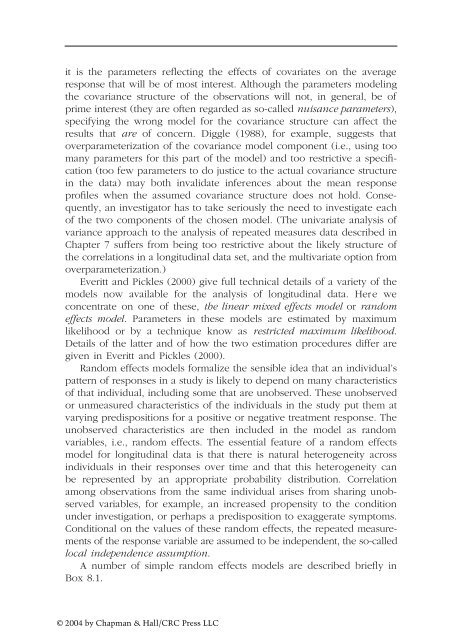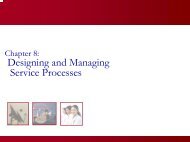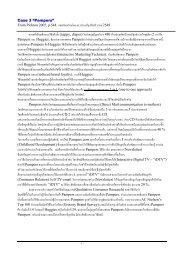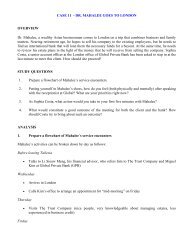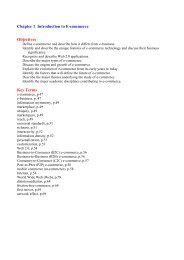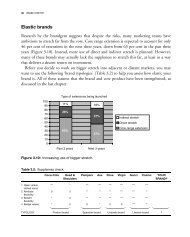Brian S. Everitt A Handbook of Statistical Analyses using SPSS
Brian S. Everitt A Handbook of Statistical Analyses using SPSS
Brian S. Everitt A Handbook of Statistical Analyses using SPSS
You also want an ePaper? Increase the reach of your titles
YUMPU automatically turns print PDFs into web optimized ePapers that Google loves.
it is the parameters reflecting the effects <strong>of</strong> covariates on the average<br />
response that will be <strong>of</strong> most interest. Although the parameters modeling<br />
the covariance structure <strong>of</strong> the observations will not, in general, be <strong>of</strong><br />
prime interest (they are <strong>of</strong>ten regarded as so-called nuisance parameters),<br />
specifying the wrong model for the covariance structure can affect the<br />
results that are <strong>of</strong> concern. Diggle (1988), for example, suggests that<br />
overparameterization <strong>of</strong> the covariance model component (i.e., <strong>using</strong> too<br />
many parameters for this part <strong>of</strong> the model) and too restrictive a specification<br />
(too few parameters to do justice to the actual covariance structure<br />
in the data) may both invalidate inferences about the mean response<br />
pr<strong>of</strong>iles when the assumed covariance structure does not hold. Consequently,<br />
an investigator has to take seriously the need to investigate each<br />
<strong>of</strong> the two components <strong>of</strong> the chosen model. (The univariate analysis <strong>of</strong><br />
variance approach to the analysis <strong>of</strong> repeated measures data described in<br />
Chapter 7 suffers from being too restrictive about the likely structure <strong>of</strong><br />
the correlations in a longitudinal data set, and the multivariate option from<br />
overparameterization.)<br />
<strong>Everitt</strong> and Pickles (2000) give full technical details <strong>of</strong> a variety <strong>of</strong> the<br />
models now available for the analysis <strong>of</strong> longitudinal data. Here we<br />
concentrate on one <strong>of</strong> these, the linear mixed effects model or random<br />
effects model. Parameters in these models are estimated by maximum<br />
likelihood or by a technique know as restricted maximum likelihood.<br />
Details <strong>of</strong> the latter and <strong>of</strong> how the two estimation procedures differ are<br />
given in <strong>Everitt</strong> and Pickles (2000).<br />
Random effects models formalize the sensible idea that an individual’s<br />
pattern <strong>of</strong> responses in a study is likely to depend on many characteristics<br />
<strong>of</strong> that individual, including some that are unobserved. These unobserved<br />
or unmeasured characteristics <strong>of</strong> the individuals in the study put them at<br />
varying predispositions for a positive or negative treatment response. The<br />
unobserved characteristics are then included in the model as random<br />
variables, i.e., random effects. The essential feature <strong>of</strong> a random effects<br />
model for longitudinal data is that there is natural heterogeneity across<br />
individuals in their responses over time and that this heterogeneity can<br />
be represented by an appropriate probability distribution. Correlation<br />
among observations from the same individual arises from sharing unobserved<br />
variables, for example, an increased propensity to the condition<br />
under investigation, or perhaps a predisposition to exaggerate symptoms.<br />
Conditional on the values <strong>of</strong> these random effects, the repeated measurements<br />
<strong>of</strong> the response variable are assumed to be independent, the so-called<br />
local independence assumption.<br />
A number <strong>of</strong> simple random effects models are described briefly in<br />
Box 8.1.<br />
© 2004 by Chapman & Hall/CRC Press LLC


